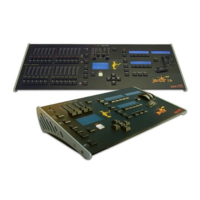MIDI Control JesterML Operating Manual
73-406-00 Issue 1.0 43 of 65
MIDI Control
Simple MIDI
Before using MIDI, you must first activate it in Setup. To do this, press and hold
SHIFT and MODE, then navigate to the <MIDI Setup> option and press ENTER, then
toggle the <Disabled> to read <Enabled>.
Once MIDI is activated, plug in a MIDI cable from a keyboard to the MIDI ‘IN’ socket
and set the desk to Preset mode. Any note played on the keyboard will turn a
channel on (JesterML24 only).
If this doesn’t work, someone may have been experimenting with the MIDI settings
on the desk, go into Setup and perform a desk reset, then re-activate MIDI.
On the JesterML, MIDI Notes control presets or submasters, depending on the mode.
It is thus of most use on the JesterML24 desk, since the JesterML does not have
either. The introduction to MIDI below will help if you need or want to know the
technical details.
Introduction to MIDI
MIDI (Musical Instrument Digital Interface) was originally designed as a means of
communication between electronic musical instruments. Some of the concepts
involved are important to understand before starting to program the desk to respond
in a particular way to MIDI commands.
Communication
MIDI is a means of two way communication between musical instruments.
Transmit and Receive Channels
MIDI has separate Transmit and Receive channels numbered 1 to 16.
By setting Receive to a particular channel, only the signals that are wanted will be
received.
Alternatively, Receive may be set to respond to all channels <--> so that any MIDI
information transmitted will be received. The Transmit channel must be set to a
specific value on the sending instrument. For two MIDI instruments to communicate
with each other in a system with many other instruments connected, they must be set
up to use Transmit and Receive channels that are not used by other instruments.
Note Numbers
The MIDI standard assigns ‘Note Numbers’ to musical notes. Middle C is number 60.
By default, octaves are mapped to the 12 presets/submasters (there are 12 notes in
a MIDI octave since it includes both the black and white notes on a piano keyboard).
However, this setting can be changed so that a specific MIDI Note is mapped to the
first preset /submaster.
Velocity Sensing
Some keyboards have this function. It enables the musician to control the loudness
of the music by playing notes and chords delicately for soft music or hard for loud

